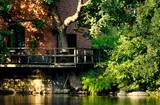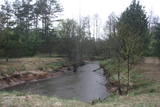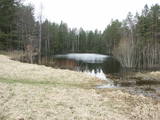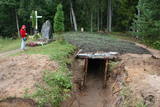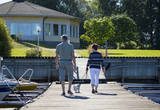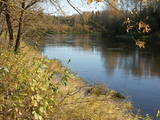| Nr | Nosaukums | Apraksts |
|---|---|---|
|
Svartas muiža ir viena no senākajām muižas ēkām Somijā, kuras vēsture ir vairāk nekā divi simti gadu. Lauku viesnīca sastāv no piecām dažādām vēsturiskām ēkām, kas atrodas idilliskā parkā ar netālu plūstošu gleznainu upi. Netālu no muižas atrodas restorāns un muzejs, kur var doties ekskursijā. |
||
|
Dabas liegums atrodas dienvidos no bijušā Ventspils – Liepājas dzelzceļa un ietver Užavas upi (t.sk. vecupes un veco meliorācijas sistēmu) ieskaujošās pļavas aptuveni 6 kilometru garumā, kas padomju laikā tika izmantotas kā kolhoza lauki (dažādas lauksaimniecības kultūras, siens), bet tagad pamazām aizaug ar krūmāju (nepieciešama regulāra pļaušana). Aizsargājamās vērtības – retas putnu sugas, t.sk. griezes, dažādi pļavu biotopi un augu sugas. Teritorija nav piemērota tūrisma aktivitātēm. Pietiekami labs priekšstats par Užavas augšteci rodas arī to vērojot „no malas” – no Alsungas - Bērzkalnu ceļa, kura malā pie Užavas upes izveidots informācijas stends. No tā pārskatāma lieguma ziemeļu daļa.
|
||
|
1916. g., kad Latvijas teritoriju bija okupējusi vācu armija, tās gūstekņiem bija jāpiedalās spaidu darbos, t.sk. jāceļ šaursliežu dzelzceļi, ar kuru palīdzību tā izveda Latvijas koksni. Arī Viesītes pusē cauri mežiem un pāri purviem izbūvēja šaursliežu dzelzceļa tīklu (sliežu platums 600 mm) ap 130 km garumā, kas Viesīti (atradās depo) savienoja ar Neretu, Aknīsti, Jēkabpili un Daudzevu. Ar mazbānīti pēc 2. pasaules kara pārvadāja koksni un pasažierus. Pēdējais vilciens šajās līnijās beidza kursēt 1972. g. 31. augustā.
Muzeja apskate gida pavadībā vai individuāli: lokomotīve Mi – 635, pasažieru un preču vagoni, kokmateriālu pārvadāšanas platforma un 2 drezīnas.
|
||
|
"Gusts Apinis" atrodas Vidzemes augstienē, Amatas novadā. Uzņēmums unikāls ar to, ka audzē netradicionālas kultūras Latvijā: kvinoju, amarantu, prosu, lēcas u.t.t. Ražo no izaudzētiem produktiem miltus un makaronus (griķu, griķu-kvinojas). Piedāvā līdzņemšanai piknika grozus, kuru saturs sagatavots no pašu ražoto produktu ēdieniem. |
||
|
Ezernieku apkārtnē novērojamas karsta parādības un to raksturīgākās izpausmes - sausas vai ar ūdeni pildītas dažādu formu un lieluma kritenes, to grupas, ūdensrijēji u.c. Visneparastākās kritenes ir Vecezers un Linezers. Linezera ūdens pēdējo pārdesmit gadu laikā ir vairākkārt aizplūdis pazemē, atklājot līdz 9 m dziļu ezerdobi. Tā ir neregulāra un līdz šim pilnībā neizskaidrota dabas parādība. Apkārt Linezeram izveidota apskates taka.
|
||
|
Restorāns atrodas Abavas upes krastā, Pūrē, blakus Šokolādes muzejam. Te sastopama mierpilna atmosfēra, lai katrs klients gūtu sev jaunas emocijas caur garšu pasauli ar tās neizmērojamām iespējām. Restorānā pieejama arī plaša vīnu izvēle. |
||
|
Mierīga vieta dabas tuvumā, kur lieliski atpūsties. Ēdiens gatavots no Hiiumaa apkārtnē pieejamām izejvielām atbilstoši viesu vēlmēm. Papildus var baudīt autentisku malkas apkures saunu un peldi mucā, bērniem iekārtots rotaļu laukums. |
||
|
Atrodas Sēlijas paugurvaļņa vienā no augstākajiem punktiem – Borīškalnā. No atjaunotā torņa pārskatāms Saukas ezers un tam pieguļošie meži un lauksaimniecības zemes. Netālu – zemnieku saimniecība „Kalna Ļūdāni”, kuras saimnieks ar mājlopu palīdzību veido un uztur apkārtnes ainavu. |
||
|
1948. gada oktobrī pret padomju varu noskaņotie nacionālie partizāni Īles mežos izveidoja 9 x 6 m lielu bunkuru, lai cīnītos pret pastāvošo iekārtu un ideoloģiju. Piecus mēnešus vēlāk Valsts drošības komiteja devās uzbrukumā minētajam bunkuram kā rezultātā pēc piecu stundu ilgas cīņas 15 partizāni gāja bojā, bet 9 saņēma gūstā. Lai atcerētos šo vēstures notikumu, Īles bunkurs ir atjaunots un brīvi pieejams ikvienam interesentam.
|
||
|
Krodziņš Kaali jau ilgus gadus saviem viesiem piedāvā labākos igauņu un sāremiešu ēdienus un dzērienus no vietējām izejvielām, kā arī iepazīstina ar salas kultūru un vēsturi. Kaali meteorīta krātera un muzeja apmeklētāji šeit var nobaudīt gardu maltīti. |
||
|
Ezeres kultūrvēstures un novadpētniecības materiālu krātuve “Muitas nams” ir izveidota vēsturiski nozīmīgā ēkā, kur, II pasaules kara noslēgumam tuvojoties, 1945. gada 8. maijā tika parakstīts Kurzemes katlā ielenkto vācu karaspēka daļu kapitulācijas akts. Ar to tiek uzskatīts, ka Ezerē faktiski beidzies II pasaules karš. Krātuves materiālu ekspozīcijas ir no Ezeres pagasta senvēstures līdz šodienai, tai skaitā ezernieku vaļasprieki. |
||
|
Darbība uzsākta 2014. g. pavasarī. Atpūtas pasākumi un brīvā laika pavadīšanas iespējas visa vecuma cilvēkiem. Radošās darbnīcas, dažādas lekcijas, izglītojošas un attīstošas nodarbības, ārpusskolas aktivitātes bērniem. Ģimenēm draudzīgi. Iestādē notiek atpūtas un brīvā laika nodarbības dažāda vecuma cilvēkiem. Radošās darbnīcas un dažādās lekcijas ir orientētas uz ģimenēm un veicina to radošumu. Pūķu palaišanas process noris rituāla veidā – bērni debesīs palaiž savus sapņus. |
||
|
Kultūras tūrisma cienītājiem šī ir viena no pirmajām vietām, kas jāapmeklē nacionālajā parkā. Nelielais ciems izvietojies Ūlas ielejas labajā krastā, kur cilvēki ir dzīvojuši jau akmens laikmetā, par ko liecina atsevišķi savrupatradumi. Zervinos atrodas liela meža masīva vidū. Ja uz to dodamies ar automašīnu, vienīgais „drošais” ceļš ved no Mančagires puses. Zervinos sākas ar grantētu lauku ceļu krustojumu, kura vidū slejas koka krucifikss. Te ir jādodas pa labi, kur redzamas simtgadīgas koka ēkas un sētas, kas saglabājušas veco plānojumu. Zervinos patiesi var iejusties 18. – 19. gs. laika dimensijā. Ne velti, šis ir viens no visvairāk pētītajiem Dienvidlietuvas etnogrāfiskajiem ciemiem. Dodoties tālāk, ir redzama Ūlas upe un tilts – laba un pat speciāli izveidota vieta, kur var uzsākt braucienu ar laivu. |
||
|
Viesnīca atrodas netālu no jūras, mierīgā vidē, tikai īsa gājiena attālumā no Ekenas centra Raseborgā. Tuvumā atrodas restorāni, veikali, dzelzceļa stacija un pludmales. |
||
|
Atvērtā permakultūras saimniecība “Lejas Varicēni” aicina iepazīt alternatīvu veidu, kā saimniekot laukos. Raķetes krāsnis, saules paneļu un saules kolektora sistēma DIY vai pašu rokām, hobitu namiņš, saules žāvētājs, paugurdobes un citas alternatīvas metodes, kā efektīvi un videi draudzīgi dzīvot un saimniekot laukos. |
||
|
Teritorija, kas aptuveni 20 km garumā „piekļāvusies” abiem Aiviekstes upes krastiem. Dabas parka galvenā vērtība ir palieņu pļavas (un citi pļavu biotopi), kas ir ļoti nozīmīga daudzu augu un dzīvnieku (īpaši – putnu) sugu dzīves vieta. Ūdenstūristiem, kas laivo pa Aivieksti, nakšņošana ir jāplāno tikai šim mērķim paredzētās vietās!
|
||
|
Lielā aplokā, kas brīvi pieejams bērniem un viņu vecākiem saskarsmei ar dzīvo dabu, ganās kazas, cūkas, mājputni un citi dzīvnieki. Apskatāmi truši. Sezonas laikā piedāvā mājputnu olas. |
||
|
Atrodas pilsētas centrālajā daļā, Latgales iela'88 b. Mūsdienās redzamās vietā 1685. g. par Krakovas karavadoņa Beļinska līdzekļiem bija uzcelta koka baznīca, ko atjaunoja 1749. g., līdz 1887. g. tā nodega negaisa laikā. Gadu vēlāk sākās divtorņu baznīcas būvniecība (gotikas stils). To iesvētīja 1904. g. Šis ir viens no iespaidīgākajiem Latvijas dievnamiem. Uzmanību ir vērts pievērst vitrāžām ar Sv. Meinarda un Alberta attēliem. Blakus baznīcai atrodas Rēzeknes - Aglonas diecēzes centrs ar bīskapa sēdekli. |
||
|
10 km garais pārgājienu maršruts iepazīstina ar vienu no vēl retajiem, cilvēka mazāk ietekmētajiem Daugavas senlejas posmiem. Tā sākums – Aizkraukle, finišs – Skrīveri. Gar upes krastu izvietotas atpūtas vietas. Maršrutu var braukt arī ar velosipēdu. |
||
|
To start the tour you take a train from Riga to Liepaja, a city with white sandy beaches and a lively cafe culture. The route goes through suburbs of Liepaja to the former millitary town where you see the Orthodox cathederal, old naval fortifications, former barracks and an imposing military prison which is now a tourism site. Pavilosta is a small seaside town and a favourite with windsurfers. Next the route follows the picturesque coastline, including steep banks at Jurkalne and finishes at the well-maintained town of Ventspils. Then along to fishing villages that are home to the tiny Finno-Ugric ethnic group, the Livs. At Cape Kolka the Baltic Sea meets the Gulf of Riga. Here, sampling the local smoked fish is a must. Further on, the route crosses three different types of sea shore – the stony beach at Kaltene, a sandy one at Upesgriva and coastal meadows at Engure. Finish with the trails at Kemeri National Park and return to Riga from the popular resort town of Jūrmala. |
||
